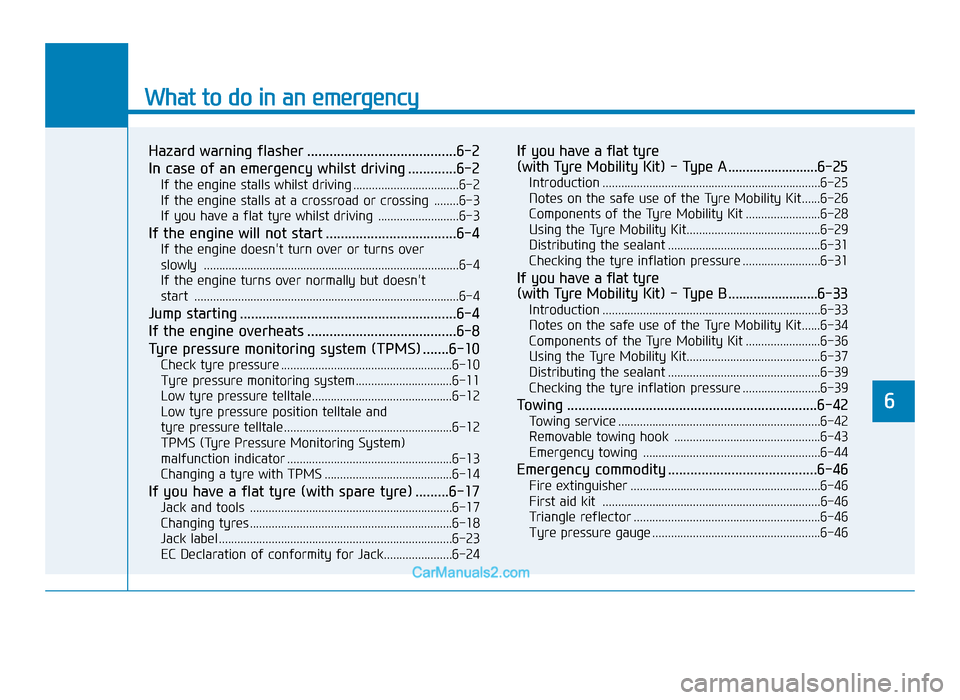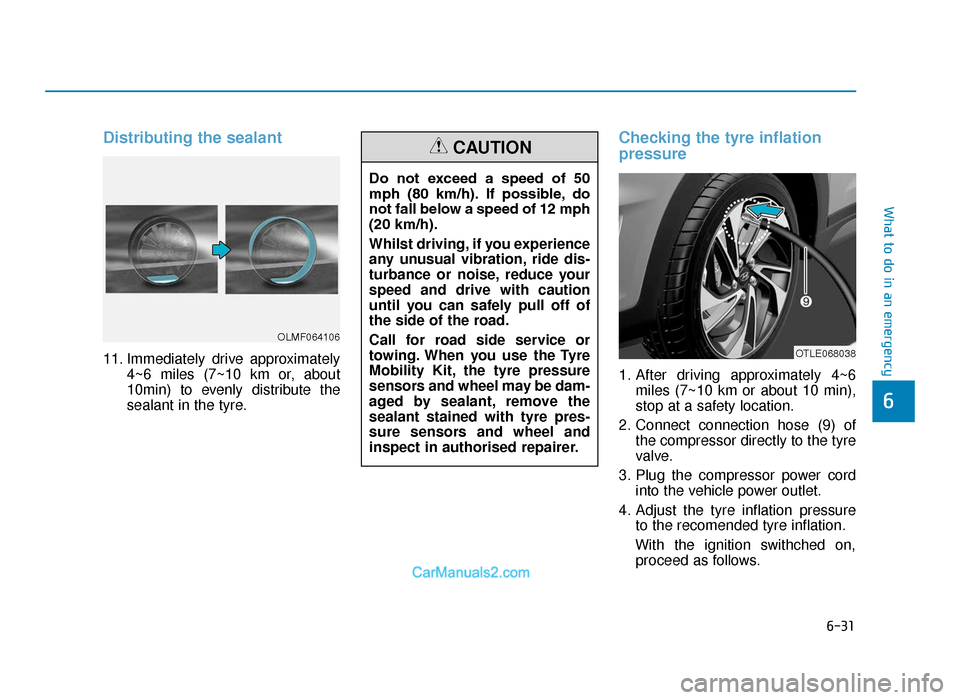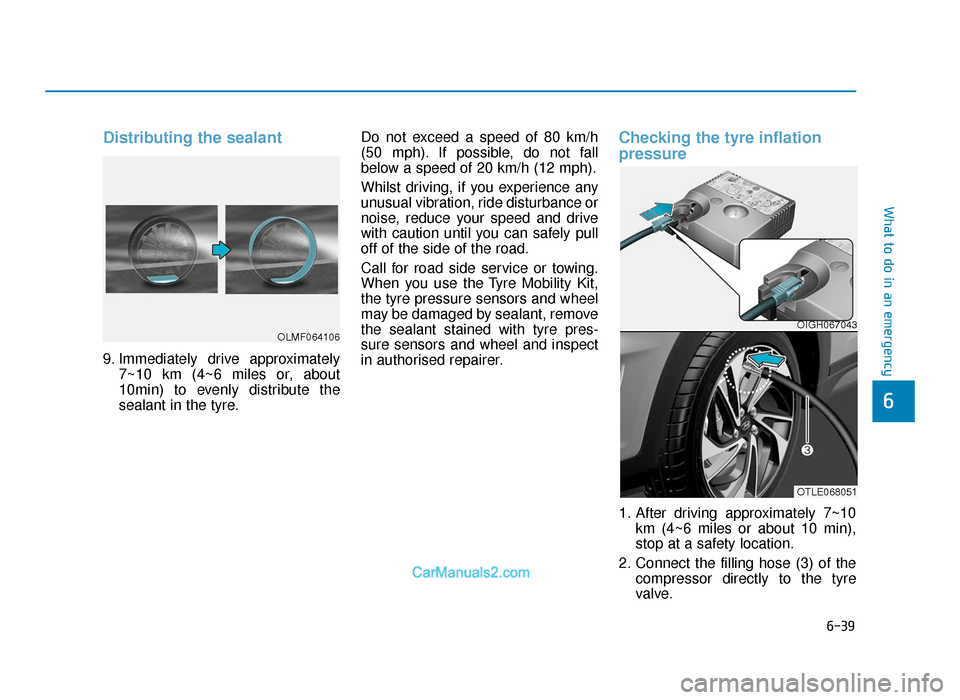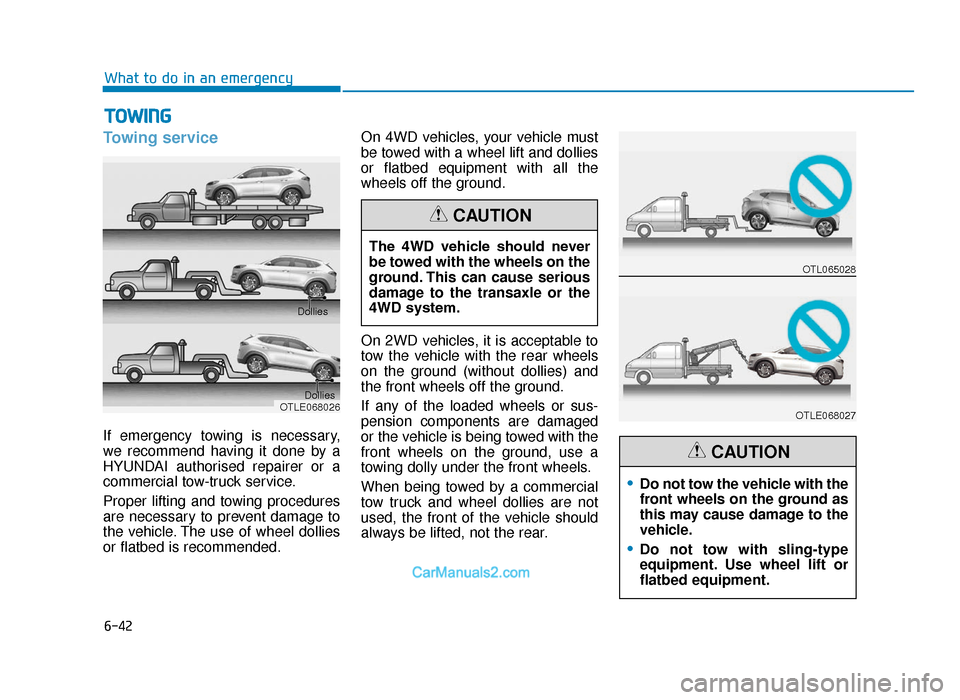2019 Hyundai Tucson emergency towing
[x] Cancel search: emergency towingPage 397 of 685

5-73
Driving your vehicle
5
• Always hold the steering wheelfirmly when you are driving off-
road.
Emergency precautions
Tyres
Do not use tyre and wheel with dif-
ferent size and type from the one
originally installed on your vehicle. It
can affect the safety and perform-
ance of your vehicle, which could
lead to steering failure or rollover
causing serious injury.
When replacing the tyres, be sure to
equip all four tyres with the tyre and
wheel of the same size, type, tread,
brand and load-carrying capacity. If
you equip your vehicle with any
tyre/wheel combination not recom-
mended by HYUNDAI for off-road
driving, you should not use these
tyres for highway driving.
Towing
4WD vehicles must be towed with a
wheel lift and dollies or flatbed equip-
ment with all the wheels off the
ground. For more details, refer to
"Towing" in chapter 6.
Dynamometer testing
A full-time 4WD vehicle must be test-
ed on a special four wheel chassis
dynamometer.
OTLE055003
Do not grab the inside of the
steering wheel when you are
driving off-road. You may hurt
your arm by a sudden steering
bonnet or from steering wheel
rebound due to an impact with
objects on the ground. You
could lose control of the steer-
ing wheel which may lead to
serious injury or death.
WARNING
Never start or run the engine
whilst a full-time 4WD vehicle is
raised on a jack. The vehicle can
slip or roll off of a jack causing
serious injury or death to you or
those nearby.
WARNING
TLe UK 5.qxp 5/10/2018 12:23 PM Page 73
Page 504 of 685

What to do in an emergency
Hazard warning flasher ........................................6-2
In case of an emergency whilst driving .............6-2
If the engine stalls whilst driving ..................................6-2
If the engine stalls at a crossroad or crossing ........6-3
If you have a flat tyre whilst driving ..........................6-3
If the engine will not start ...................................6-4
If the engine doesn't turn over or turns over
slowly ......................................................................\
............6-4
If the engine turns over normally but doesn't
start ....................................................................\
.................6-4
Jump starting ..........................................................6-4
If the engine overheats ........................................6-8
Tyre pressure monitoring system (TPMS) .......6-10
Check tyre pressure .......................................................6-10
Tyre pressure monitoring system...............................6-11
Low tyre pressure telltale.............................................6-12
Low tyre pressure position telltale and
tyre pressure telltale ......................................................6-12
TPMS (Tyre Pressure Monitoring System)
malfunction indicator .....................................................6-13
Changing a tyre with TPMS .........................................6-14
If you have a flat tyre (with spare tyre) .........6-17
Jack and tools .................................................................6-17
Changing tyres .................................................................6-18
Jack label ........................................................................\
...6-23
EC Declaration of conformity for Jack......................6-24
If you have a flat tyre
(with Tyre Mobility Kit) - Type A .........................6-25
Introduction ......................................................................6-\
25
Notes on the safe use of the Tyre Mobility Kit......6-26
Components of the Tyre Mobility Kit ........................6-28
Using the Tyre Mobility Kit...........................................6-29
Distributing the sealant .................................................6-31
Checking the tyre inflation pressure .........................6-31
If you have a flat tyre
(with Tyre Mobility Kit) - Type B .........................6-33
Introduction ......................................................................6-\
33
Notes on the safe use of the Tyre Mobility Kit......6-34
Components of the Tyre Mobility Kit ........................6-36
Using the Tyre Mobility Kit...........................................6-37
Distributing the sealant .................................................6-39
Checking the tyre inflation pressure .........................6-39
Towing ...................................................................6-42
Towing service .................................................................6-42
Removable towing hook ...............................................6-43
Emergency towing .........................................................6-44
Emergency commodity ........................................6-46
Fire extinguisher .............................................................6-46
First aid kit ......................................................................6-\
46
Triangle reflector ............................................................6-46
Tyre pressure gauge ......................................................6-46
6
TLe UK 6.qxp 5/10/2018 1:19 PM Page 1
Page 507 of 685

6-4
IF THE ENGINE WILL NOT START
What to do in an emergency
If the engine doesn't turn over
or turns over slowly
• Be sure the shift lever is in N(Neutral) or P (Park) if it is an auto-
matic transaxle/dual clutch trans-
mission vehicle. The engine starts
only when the shift lever is in N
(Neutral) or P (Park).
• Check the battery connections to be sure they are clean and tight.
• Turn on the interior light. If the light dims or goes out when you operate
the starter, the battery is drained.
Do not push or pull the vehicle to start
it. This could cause damage to your
vehicle. See instructions for "Jump
Starting" provided in this chapter.
If the engine turns over nor-
mally but doesn’t start
• Check the fuel level and add fuel if necessary.
If the engine still does not start, we
recommend that you call a HYUNDAI
authorised repairer for assistance. Jump starting can be dangerous if
done incorrectly. Follow the jump
starting procedure in this section to
avoid serious injury or damage to
your vehicle. If in doubt about how to
properly jump start your vehicle, we
strongly recommend that you have a
service technician or towing service
do it for you.
Push or pull starting the vehicle
may cause the catalytic con-
verter to overload which can
lead to damage to the emission
control system.
CAUTION
JUMP STARTING
TLe UK 6.qxp 5/10/2018 1:20 PM Page 4
Page 521 of 685

6-18
What to do in an emergency
If it is hard to loosen the tyre hold-
down wing bolt by hand, you can
loosen it easily using the jack handle.
1. Put the jack handle (1) inside of the tyre hold-down wing bolt.
2. Turn the tyre hold-down wing bolt counterclockwise with the jack
handle.
Changing tyres
A vehicle can slip or roll off of a
jack causing serious injury or
death to you or those nearby.
Take the following safety pre-
cautions:
•Do not get under a vehicle
that is supported by a jack.
•NEVER attempt to change a
tyre in the lane of traffic.
ALWAYS move the vehicle
completely off the road on
level, firm ground away from
traffic before trying to change
a tyre. If you cannot find a
level, firm place off the road,
call a towing service for assis-
tance.
•Be sure to use the jack pro-
vided with the vehicle.
(Continued)
WARNING
(Continued)
•ALWAYS place the jack on the
designated jacking positions
on the vehicle and NEVER on
the bumpers or any other part
of the vehicle for jacking sup-
port.
•Do not start or run the engine
whilst the vehicle is on the
jack.
•Do not allow anyone to remain
in the vehicle whilst it is on
the jack.
•Keep children away from the
road and the vehicle.
OTLE065040
TLe UK 6.qxp 5/10/2018 1:20 PM Page 18
Page 534 of 685

6-31
What to do in an emergency
6
Distributing the sealant
11. Immediately drive approximately4~6 miles (7~10 km or, about
10min) to evenly distribute the
sealant in the tyre.
Checking the tyre inflation
pressure
1. After driving approximately 4~6miles (7~10 km or about 10 min),
stop at a safety location.
2. Connect connection hose (9) of the compressor directly to the tyre
valve.
3. Plug the compressor power cord into the vehicle power outlet.
4. Adjust the tyre inflation pressure to the recomended tyre inflation.
With the ignition swithched on, proceed as follows.
Do not exceed a speed of 50
mph (80 km/h). If possible, do
not fall below a speed of 12 mph
(20 km/h).
Whilst driving, if you experience
any unusual vibration, ride dis-
turbance or noise, reduce your
speed and drive with caution
until you can safely pull off of
the side of the road.
Call for road side service or
towing. When you use the Tyre
Mobility Kit, the tyre pressure
sensors and wheel may be dam-
aged by sealant, remove the
sealant stained with tyre pres-
sure sensors and wheel and
inspect in authorised repairer.
CAUTION
OTLE068038
OLMF064106
TLe UK 6.qxp 5/10/2018 1:21 PM Page 31
Page 542 of 685

6-39
What to do in an emergency
Distributing the sealant
9. Immediately drive approximately7~10 km (4~6 miles or, about
10min) to evenly distribute the
sealant in the tyre. Do not exceed a speed of 80 km/h
(50 mph). If possible, do not fall
below a speed of 20 km/h (12 mph).
Whilst driving, if you experience any
unusual vibration, ride disturbance or
noise, reduce your speed and drive
with caution until you can safely pull
off of the side of the road.
Call for road side service or towing.
When you use the Tyre Mobility Kit,
the tyre pressure sensors and wheel
may be damaged by sealant, remove
the sealant stained with tyre pres-
sure sensors and wheel and inspect
in authorised repairer.
Checking the tyre inflation
pressure
1. After driving approximately 7~10
km (4~6 miles or about 10 min),
stop at a safety location.
2. Connect the filling hose (3) of the compressor directly to the tyre
valve.
6
OLMF064106OIGH067043
OTLE068051
TLe UK 6.qxp 5/10/2018 1:22 PM Page 39
Page 545 of 685

6-42
What to do in an emergency
Towing service
If emergency towing is necessary,
we recommend having it done by a
HYUNDAI authorised repairer or a
commercial tow-truck service.
Proper lifting and towing procedures
are necessary to prevent damage to
the vehicle. The use of wheel dollies
or flatbed is recommended.On 4WD vehicles, your vehicle must
be towed with a wheel lift and dollies
or flatbed equipment with all the
wheels off the ground.
On 2WD vehicles, it is acceptable to
tow the vehicle with the rear wheels
on the ground (without dollies) and
the front wheels off the ground.
If any of the loaded wheels or sus-
pension components are damaged
or the vehicle is being towed with the
front wheels on the ground, use a
towing dolly under the front wheels.
When being towed by a commercial
tow truck and wheel dollies are not
used, the front of the vehicle should
always be lifted, not the rear.
TOWING
OTLE068026
Dollies
Dollies
•Do not tow the vehicle with the
front wheels on the ground as
this may cause damage to the
vehicle.
•Do not tow with sling-type
equipment. Use wheel lift or
flatbed equipment.
CAUTION
OTL065028
OTLE068027
The 4WD vehicle should never
be towed with the wheels on the
ground. This can cause serious
damage to the transaxle or the
4WD system.
CAUTION
TLe UK 6.qxp 5/10/2018 1:22 PM Page 42
Page 546 of 685

6-43
What to do in an emergency
6
When towing your vehicle in an
emergency without wheel dollies:
1. Place the ignition switch in theACC position.
2. Place the shift lever in N (Neutral).
3. Release the parking brake.
Removable towing hook
1. Open the tailgate, and remove the towing hook from the tool case.
2. Remove the hole cover pressingthe lower part of the cover on the
front bumper.
3. Install the towing hook by turning it clockwise into the hole until it is
fully secured.
4. Remove the towing hook and install the cover after use.
Failure to place the shift lever in
N (Neutral) may cause internal
damage to the transaxle.
CAUTION
OTLE068021
OTLE068022
OTLE068024
■Front
■Rear
If your vehicle is equipped with
a rollover sensor, place the igni-
tion switch in the LOCK/OFF or
ACC position when the vehicle
is being towed. The side impact
and curtain air bag may deploy
if the sensor detects the situa-
tion as a rollover.
WARNING
TLe UK 6.qxp 5/10/2018 1:22 PM Page 43